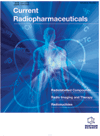- Home
- A-Z Publications
- Current Radiopharmaceuticals
- Previous Issues
- Volume 4, Issue 1, 2011
Current Radiopharmaceuticals - Volume 4, Issue 1, 2011
Volume 4, Issue 1, 2011
-
-
Easy and Efficient 111Indium Labeling of Long-Term Stored DTPA Conjugated Protein
More LessAuthors: Amarnadh Nalla, Inge Buch and Birger HesseThe labelling efficiency of long-term stored DTPA-conjugates has not been reported previously even though DTPA has been in extensive use as metal chelator in the development of radiopharmaceuticals and contrast agents. DTPA is often used as a bifunctional chelating agent conjugated to tumor targeting vehicles such as monoclonal antibodies and receptor directed peptides. The purpose of this study was to monitor the la Read More
-
-
-
A Brief Evaluation of Tumor Imaging in Mice with 99mTc-glucarate Including a Comparison with 18F-FDG
More LessAuthors: Dengfeng Cheng, Mary Rusckowski, Yuzhen Wang, Yuxia Liu, Guozheng Liu, Xinrong Liu and Donald HnatowichObjective: Recently 99mTc-glucarate, a radiolabeled glucose analogue, has been considered as a SPECT alternative to 18F-FDG and PET for non-invasive detection of certain tumors. Thus far there have been few studies on 99mTcglucarate for tumor imaging and fewer, if any, studies comparing 99mTc-glucarate with 18F-FDG. As a preliminary indication of the properties of 99mTc-glucarate as a possible substitute for 1 Read More
-
-
-
Strategies for Non-Invasive Molecular Imaging of Acute Allograft Rejection by Gamma Scintigraphy and Positron Emission Tomography
More LessAuthors: Alexander Grabner, Uta Schnockel, Dominik Kentrup, Michael Schafers and Stefan ReuterThe number of patients necessitating treatment for end-stage organ failure, and therefore, the number of allograft recipients, increases. Despite the introduction of new and effective immunosuppressive drugs, acute cellular graft rejection (AR) is still a major risk for graft survival. Hence, early detection and treatment of AR is crucial to limit the inflammatory process and preserve the function of the transplant. Nowadays, AR ca Read More
-
-
-
Improved Synthesis of 2'-deoxy-2'-[18F]fluoro-5-Methyl-1-β-DArabinofuranosyluracil ([18F]FMAU)
More LessAuthors: Zibo Li, Hancheng Cai and Peter S. Conti[18F]FMAU is an established PET probe used to monitor cellular proliferation. For clinical applications, a fully automated cGMP-compliant radiosynthesis would be preferred. However, the current synthesis of [18F]FMAU requires HBr activation of the sugar prior to the coupling with silylated uracil. This multiple step procedure makes the development of an automated protocol difficult and complicated. In this study, w Read More
-
-
-
Magnetic Resonance Contrast Media Sensing In Vivo Molecular Imaging Agents: An Overview
More LessMetabolic imaging is commonly performed by nuclear medicine facilities such as PET or SPECT, etc. The production and biomedical applications of bio-molecular sensing in vivo MRI metabolic contrast agents has recently become of great universal research interest, which follows its great success as a potential cost effective, less radioactive, nuclear medicine alternative. Temperature, redox potential, enzyme activity, free Read More
-
-
-
PET Measurements of cAMP-Mediated Phosphodiesterase-4 with (R)-[11C]Rolipram
More LessAuthors: Miran Kenk, Adam Thomas, Mireille Lortie, Rob deKemp, Rob S. Beanlands and Jean N. DaSilvaCyclic adenosine monophosphate (cAMP) is the common second messenger in signal-transduction cascades originating at a number of monoamine receptors involved in neurotransmission, cardiac function and smooth muscle contraction. Altered regulation of cAMP synthesis (at receptors, G-protein subunits or adenylyl cyclase) and breakdown by phosphodiesterase (PDE) enzymes have been implicated in a number of patholo Read More
-
-
-
Utility of γH2AX as a Molecular Marker of DNA Double-Strand Breaks in Nuclear Medicine: Applications to Radionuclide Therapy Employing Auger Electron-Emitting Isotopes
More LessAuthors: Li-Jeen Mah, Christian Orlowski, Katherine Ververis, Assam El-Osta and Tom C. KaragiannisThere is an intense interest in the development of radiopharmaceuticals for cancer therapy. In particular, radiopharmaceuticals which involve targeting radionuclides specifically to cancer cells with the use of monoclonal antibodies (radioimmunotherapy) or peptides (targeted radiotherapy) are being widely investigated. For example, the ultra-short range Auger electron-emitting isotopes, which are discussed in this review, ar Read More
-
-
-
64Cu Labeled AmBaSar-RGD2 for micro-PET Imaging of Integrin αvβ3 Expression
More LessAuthors: Hancheng Cai, Zibo Li, Chiun-Wei Huang, Ryan Park and Peter S. ContiIntegrin αvβ3 plays a critical role in tumor-induced angiogenesis and metastasis. Previously, a 64Cu-AmBaSar- RGD monomer with high in vivo stability compared with 64Cu-DOTA-RGD was developed for integrin αvβ3 PET imaging. It has been established that dimeric RGD peptides have higher receptor-binding affinity and superior in vivo kinetics compared with monomeric RGD peptides due to the polyvalency effect. In th Read More
-
Volumes & issues
Most Read This Month
Article
content/journals/crp
Journal
10
5
false
en


